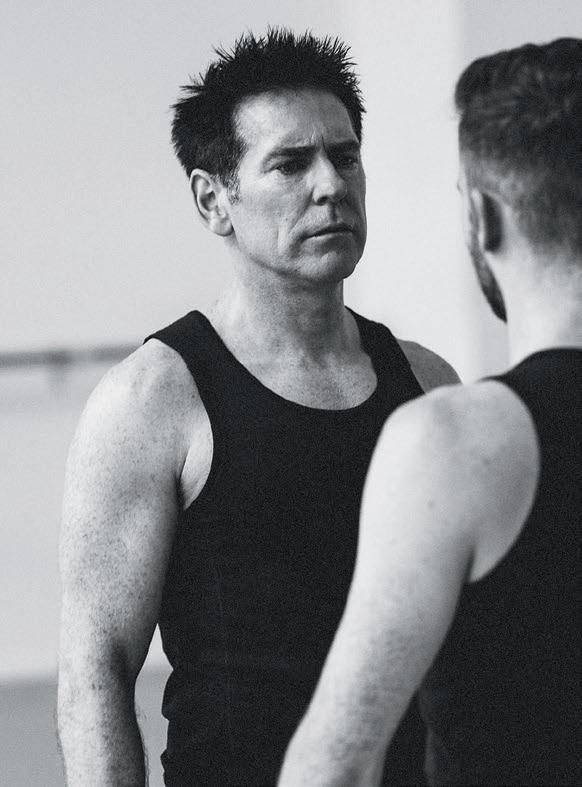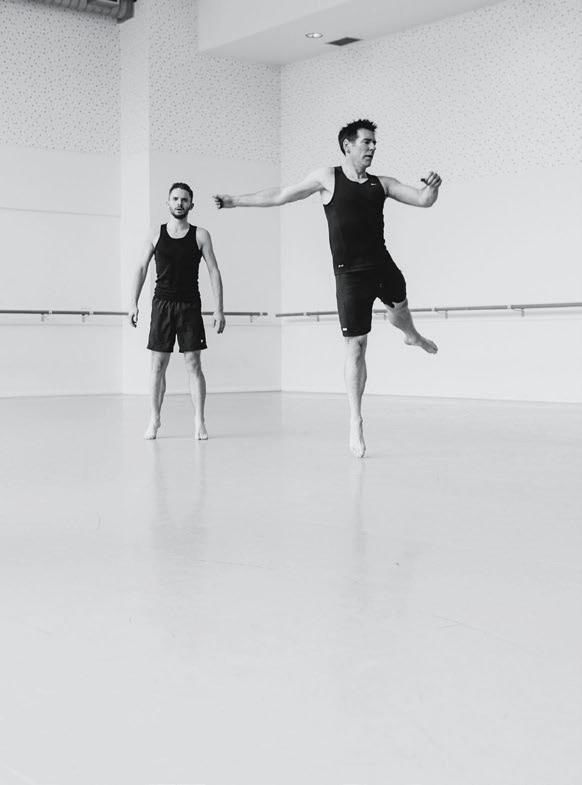
4 minute read
LOCAL FIGURE
Breandán de Gallaí A BALLET REVOLUTION
THIS CHOREOGRAPHER AND HIS COMPANY COMBINE THE INTENSITY OF STEP DANCING WITH THE STREAMLINED STYLE OF CONTEMPORARY DANCE, DETERMINED TO ROOT THIS TRADITIONAL GENRE IN TODAY’S ARTISTIC LANDSCAPE.
By Guillaume Jan Photos Mickaël A. Bandassak
EVEN BEFORE ENTERING THE ROOM, WE CAN HEAR THE SPIRITED CLATTER OF THE HEELS AND SOLES OF “HARD SHOES”. We push through the door and are met with the sounds of tango music and the sight of two men performing inspired sequences of traditional Irish dance, clacking their feet on the grey linoleum as they rehearse. One is Breandán de Gallaí; the other is Nick O’Connell, his accomplice in all performances. With his athletic body, skyblue eyes and ready smile, the 47-year-old de Gallaí has become a legend of this Irish art. After spending ten years riding the wave of worldwide success of “Riverdance” (see inset), he is now involved in a more personal project with his own Ériu Company. “I’m exploring the possibilities offered by traditional dance in a quest to integrate it into contemporary culture,” he says. “In a ‘Riverdance’ show, to be rather tongue-in-cheek about it, this means smiling and mastering the technique so as to advance as quickly as possible. Now, dance isn’t a competition – it’s a means of expression. In the shows I create, I want the dancers to convey the emotions they’re feeling, to really show what they have inside them.” A challenge, indeed, in a country that favours theatre and literature over choreography, “eternal Cinderella of the arts,” as he prettily puts it. “In trying to escape the too-often folkloric label given Irish dancing, I sometimes feel like I’m working in a genre that doesn’t yet exist.” In short, Breandán is reinventing it. •••

FROM “FAME”TO “RIVERDANCE” He returns to the floor with Nick, his collaborator, this time to more current music, electronic sounds, a throbbing boom-boom and a few notes of Irish fiddle. The two men have removed their Everything is mesmerising, from the exactitude of their movements to the energy hard come tap shoes: lighter and their faster movemen still, with ts en betre- radiated by their bodies. chats and other ballet steps. Everything about their presentation is mesmerising, from the exacti- gradually developed a taste for the art. In 1980, when Alan tude and fluidity of their movements to the energy radiated Parker released his musical “Fame”, Breandán recalls havby their bodies to the obvious pleasure they take in dancing ing suddenly grasped all the potential that contemporary to this tune. They dance an excerpt from “Linger”, the Ériu dance truly held. At 16, he went to the United States Company’s latest show, performed for the first time in with his father, working summer jobs painting houses in Dublin in January 2016 and praised by the national press. Chicago, Illinois, and was spotted by dance fans who saw
Breandán de Gallaí travelled a long, hard road to reach his footwork. When he returned the following year, the Gus this level. He grew up in a family of seven children in a vil- Giordano Dance Academy invited him to attend classes for lage in County Donegal in north-western Ireland. He began a year. His parents gave their permission for him to stay to studying dance at age eight, with little enthusiasm, but make the most of this opportunity, provided he get back on track with his university plans when returning home: “Back then, the idea of earning a living from dance in Ireland was unthinkable; they wanted me to have a real job. So I studied applied physics”. But everything changed in 1994


IN REHEARSAL with his partner, Nick O’Connell.
following the astounding success of “Riverdance”. The young man was recruited as one of the troupe’s lead dancers and would remain with the show for nearly ten years, becoming world-famous, dancing before kings and princesses across the globe, including the Emperor of Japan, Queen Elizabeth II and Queen Sonja of Norway.
GREEK TRAGEDY
“Basically, I do Irish step dancing, with the upper body remaining fairly static and very rapid leg movements,” he explains. “But I know much more than that: I’ve studied other classic dance genres, like ballet, tap and jazz. I want to open up Irish dancing to these other styles.” Ceaselessly driven by his desire to expand the genre’s horizons, Breandán is working on an upcoming show in which he hopes to dovetail his choreography with the intensity of Greek tragedy. “But I take care to keep the spirit of Irish culture in my choreography,” he concludes. The same spirit that wholly animates him when he takes his place on the dance floor. n
Often considered the first major production to have presented Irish culture to a worldwide audience, “Riverdance” was an unexpected success story. It was originally designed as an entertaining interlude – a mere seven minutes in length – at the 1994 Eurovision contest held in Dublin. But that brief display was such a success that the producer, Moya Doherty, created an entire show based on traditional Irish dance. Since then, “Riverdance ” continues to tour worldwide and has been seen, to date, by more than 18 million spectators. Breandán de Gallaí was part of the “Riverdance” adventure from the very first show, remaining with it until 2003. He was the show’s lead dancer for eight years.










